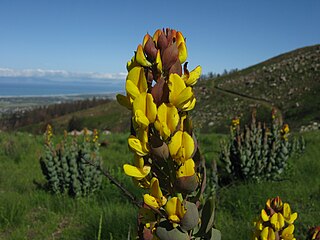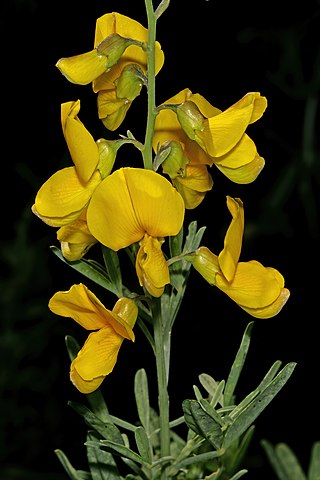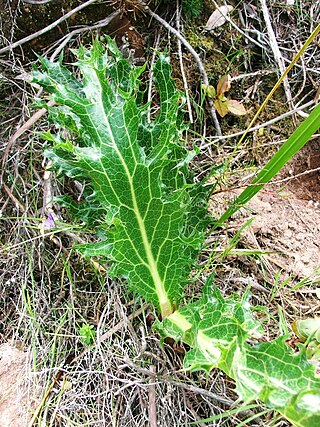
The Asclepiadoideae are a subfamily of plants in the family Apocynaceae. Formerly, they were treated as a separate family under the name Asclepiadaceae, e.g. by APG II, and known as the milkweed family.

Nepenthes mirabilis, or the common swamp pitcher-plant and tropical pitcher plant, is a carnivorous plant species. By far the most widespread of all Nepenthes, its range covers continental Southeast Asia and all major islands of the Malay Archipelago, stretching from China in the north to Australia in the south. The species exhibits great variability throughout its range. One of the more notable varieties, N. mirabilis var. echinostoma, is endemic to Brunei and Sarawak and possesses an extremely wide peristome.

Trianthema is a genus of flowering plants in the ice plant family, Aizoaceae. Members of the genus are annuals or perennials generally characterized by fleshy, opposite, unequal, smooth-margined leaves, a prostrate growth form, flowers with five perianth segments subtended by a pair of bracts, and a fruit with a winged lid. The genus contains about 30 described species growing in tropical and subtropical regions, especially Australia. One common species, Trianthema portulacastrum, desert horse purslane, is frequent as a weed in agricultural areas and is widely distributed.

Amphithalea is a genus of flowering plants in the family Fabaceae. It belongs to the subfamily Faboideae. It includes 41 species endemic to the Cape Provinces of South Africa.

Aspalathus is a genus of flowering plants in the family Fabaceae. The yellow flowers and spiny habit of some species have suggested a resemblance to Ulex europaeus, the thorny "English gorse" Accordingly, "Cape Gorse" has been proposed as a common name although the resemblance is largely superficial; for instance, gorse is thorny, whereas Aspalathus species are variously spiny or unarmed. The genus belongs to the subfamily Faboideae. There are over 270 species, mainly endemic to southwestern fynbos regions in South Africa, with over fifty occurring on the Cape Peninsula alone. The species Aspalathus linearis is commercially important, being farmed as the source of Rooibos tea.

Lessertia is a genus of flowering plants in the legume family, Fabaceae. It contains some 62 species native to eastern and southern Africa. It belongs to subfamily Faboideae.

Podalyria is a genus of flowering plants in the family Fabaceae. It includes 17 species of small trees or shrubs native to the Cape Provinces, Free State, and KwaZulu-Natal in South Africa. They inhabit Mediterranean-climate shrubland from low to high elevations, typically in rocky or sandy areas. It belongs to the subfamily Faboideae. The genus is endemic to South Africa.

Rafnia is a genus of flowering plants in the family Fabaceae. It includes 29 species of shrubs and subshrubs native to South Africa. They grow in Mediterranean-climate fynbos (shrubland) and grassland, mostly on rocky and sandy soils. Most are native to the Cape Provinces, with some extending eastwards into KwaZulu-Natal. It belongs to subfamily Faboideae.

Wolffia globosa is a species of flowering plant known by the common names Asian watermeal and duckweed. It is native to Asia and is found in parts of the Americas and Africa, where it is an introduced species. It grows in mats on the surface of calm, freshwater bodies, such as ponds, lakes, and marshes. It is a very tiny, oval-shaped plant with no leaves, stems, or roots. The body of the plant, a transparent green frond, is less than a millimeter wide. In one human experiment, processed W. globosa was reported to provide dietary protein and vitamin B12.

Fockea is a genus of succulent scrubs native to Africa south of the equator. They are members of the Asclepiadoideae (milkweeds), a subfamily of the dogbane family Apocynaceae. Of the six recognized species, only the two most widely distributed extend north of southern Africa, with F. multiflora reaching as far north as Tanzania and F. angustifolia reaching to southern Kenya. Fockea are known as water roots, a reference to the bulbous caudex characteristic of most species, which is also edible in at least some species.

Calobota is a genus of flowering plants in the legume family, Fabaceae. It includes 16 species native to North Africa and southern Africa. It belongs to the subfamily Faboideae.

Stenostelma is a genus of plants in the family Apocynaceae, first described as a genus in 1894. It is native to southern Africa, ranging from Mozambique, Zambia, and Namibia to South Africa.
Cordylogyne is a genus of plants in the family Apocynaceae, established as a genus in 1838. Species of Cordylogyne are native to southern Africa.

Tamarix usneoides, locally known as wild tamarisk, is a twiggy shrub or small evergreen tree that grows in saline habitats, semi-deserts and karroid areas in southern Africa, ranging from Angola through Namibia to the Cape Provinces of South Africa. It has a short trunk, thin branches usually growing from ground level, tiny scale-like leaves and spikes of creamy-white flowers.

Crassula pellucida is a creeping, succulent ground-cover, or low-growing, spreading succulent shrub. It is native to eastern and southern Africa, ranging from Kenya and Angola to South Africa.

Lichtensteinia is a genus of flowering plants belonging to the family Apiaceae. It is also the only genus in the tribe Lichtensteinieae, subfamily Apioideae.

Nemesia versicolor is a species of perennial flowering plant in the family Scrophulariaceae. It is endemic to the Northern and Western Cape Provinces of South Africa.
Macrostylis is a genus of flowering plants in the family Rutaceae. It includes 10 species endemic to the Cape Provinces of South Africa.















